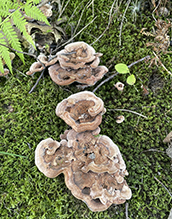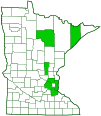Zoned Tooth
(Hydnellum concrescens)
Conservation • Description • Habitat • Ecology • Distribution • Taxonomy
Conservation Status |
|
|||||||
| IUCN Red List | not listed |
|||||||
| NatureServe | NNR - Unranked |
|||||||
| Minnesota | not listed |
|||||||
Description |
||
Zoned Tooth is an easily identified, medium-sized, widespread, and fairly common tooth fungus. It occurs in Europe and North America. In the United States it occurs in the east from Maine to Florida, west to Minnesota, Missouri, and Alabama. It also occurs on the West Coast in Oregon and northern California. It is found in summer and fall, alone or in groups but not clustered (gregarious), in dry deciduous forests. It grows on the ground under hardwoods, especially oaks. It has a mutually beneficial relationship (mycorrhizal) with the tiny rootlets of trees, absorbing sugars and amino acids while helping the tree absorb water. The West Coast version of this species has been recorded growing under conifers. In the U.K. it grows under conifers in the north and under hardwoods in the south. There may be two or more species that are currently recognized as Hydnellum concrescens. When it first appears, the cap is convex above but flat below (planoconvex) and white to creamy pink. The upper surface is covered with fine, velvety, hair-like fibers. As it ages, the cap expands. The upper surface becomes pitted or coarsely knobbed and it develops ridges radiating from the center. It sometimes develops secondary caps or “elaborate outgrowths”. Mature caps are ¾″ to 4″ (2 to 10 cm) in diameter, flat, and depressed in the center. They are concentrically zoned in color, texture, or both, dark brown in the center, tan near the margins, with an abrupt transition between zones. The upper surface is fibrous-scaly. The margins when fresh will bruise dark brown to black. Adjacent caps usually fuse together. The underside of the cap, the spore surface, is covered with short, spine-like teeth. The teeth are 1⁄32″ to ⅛″ (1 to 3 mm) long and whitish at first, soon becoming pinkish-brown, ultimately turning dark purplish-brown. The pore surface runs down the stalk. The stalk is solid, ¾″ to 1½″ (2 to 4 cm) long, and 3⁄16″ to ¾″ (0.5 to 2.0 cm) thick. It is attached to the cap off center. It is the same color as the cap and is covered with fine velvety or appressed hair-like fibers. The flesh is fibrous, tough, and dry. It is reddish-brown or pinkish-brown and obscurely concentrically zoned. It is inedible due to its tough texture and bitter, unpleasant taste. The spore print is dull brown. |
||
Similar Species |
||
Habitat and Hosts |
||
Oaks and other hardwoods |
||
Ecology |
||
Season |
||
Summer and fall |
||
Distribution |
||||
|
Sources |
|||
| 3/3/2023 | ||||
Occurrence |
||||
|
||||
Taxonomy |
|||
| Kingdom | Fungi (fungi) | ||
| Subkingdom | Dikarya | ||
| Phylum | Basidiomycota (club fungi) | ||
| Subphylum | Agaricomycotina (jelly fungi, yeasts, and mushrooms) | ||
| Class | Agaricomycetes (mushrooms, bracket fungi, puffballs, and allies) | ||
Order |
Thelephorales | ||
Family |
Bankeraceae | ||
Genus |
Hydnellum | ||
Synonyms |
|||
Calodon fasciatum Calodon zonatus Hydnellum parvum Hydnellum subsuccosum Hydnellum zonatum Hydnum fasciatum Hydnum spathulatum Hydnum vespertilio Hydnum zonatum Phaeodon zonatus |
|||
Common Names |
|||
Zoned Hydnellum Zoned Tooth Zoned Tooth Fungus |
|||
Glossary
Mycorrhizal
A symbiotic, usually beneficial relationship between a fungus and the tiny rootlets of a plant, usually a tree.
Visitor Photos |
|||||
Share your photo of this fungus. |
|||||
| This button not working for you? Simply email us at info@MinnesotaSeasons.com. Attach one or more photos and, if you like, a caption. |
|||||
Honey Fae (Farah) |
|||||
 |
|||||
MinnesotaSeasons.com Photos |
|||||
|
|||||

Visitor Videos |
|||
Share your video of this fungus. |
|||
| This button not working for you? Simply email us at info@MinnesotaSeasons.com. Attach a video, a YouTube link, or a cloud storage link. |
|||
Other Videos |
|||

Created: 3/3/2023
Last Updated:




